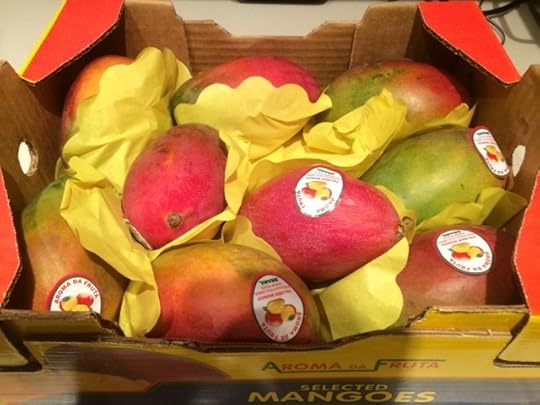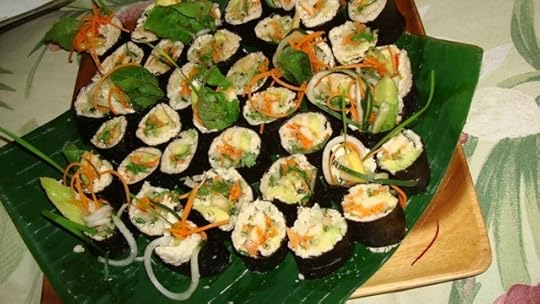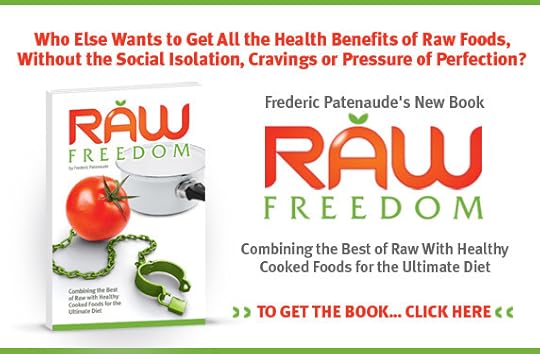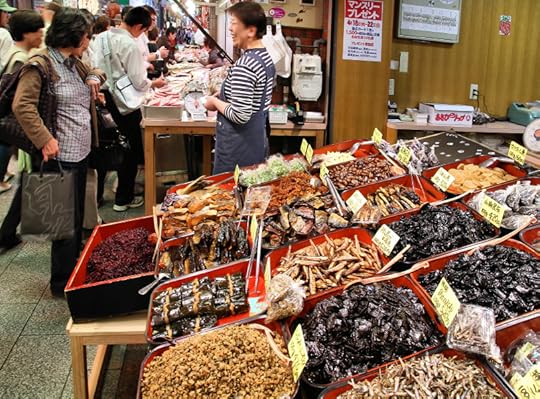Frederic Patenaude's Blog, page 36
November 28, 2013
What Fruits I Bought Last Week
Every week I go to my local fruit market. I may not eat 100% raw, but I eat more fruits than many so-called raw foodists. In fact, these days, I’m eating mostly fruits throughout the day. So I need a good selection of awesome fruits.
People complain that the fruit selection isn’t good enough in the winter, but in my experience, it’s a great time of the year to get fruits. The spring tends to be a bit sparser.
Here are some fruits I’ve been buying lately:
Mangoes
Believe it or not, I’m eating a lot of mangoes these days. They come from Brazil and are absolutely amazing. In the last few years, Brazil has become a major exporter of fruit, which is leading to better variety in the stores. Not so long ago I was eating mangoes from Israel that were also delicious. Both of these mangoes are expensive, so it’s worth it to get them by the case.
Vanilla Persimmons
This is an awesome type of persimmon. You can eat it hard like an apple, but they have the same shape as the regular persimmons (unlike the Fuyu persimmons). They come from Spain at this time of the year.
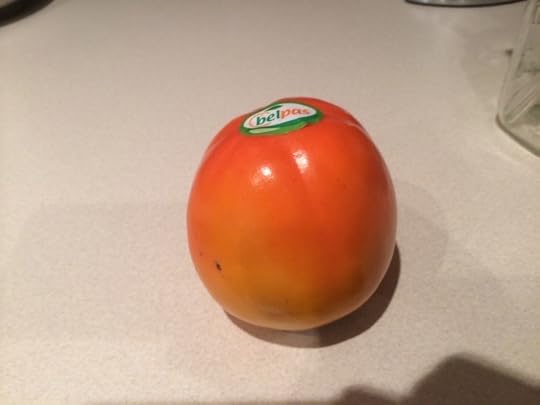
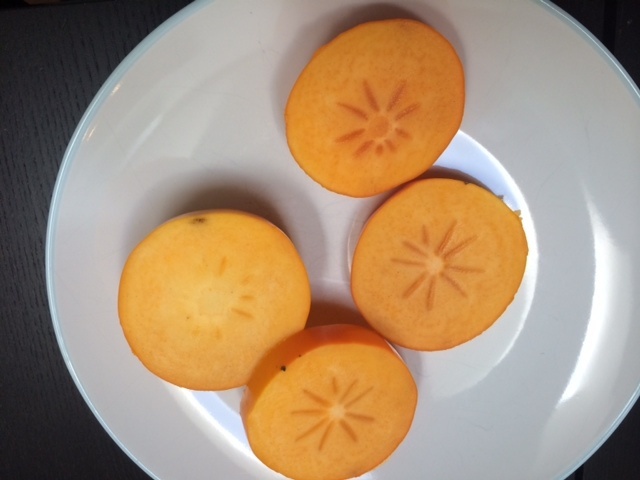
Grapes
Some excellent California grapes are in season.
Prickly Pears
Every time I get into prickly pears, I forget how amazing and underrated this fruit is. I get the kinds that are red inside, and buy a whole crate.
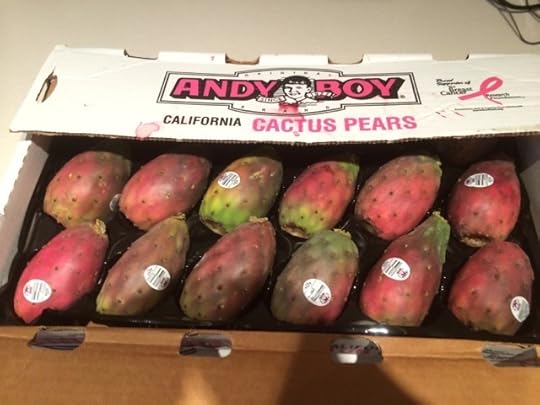
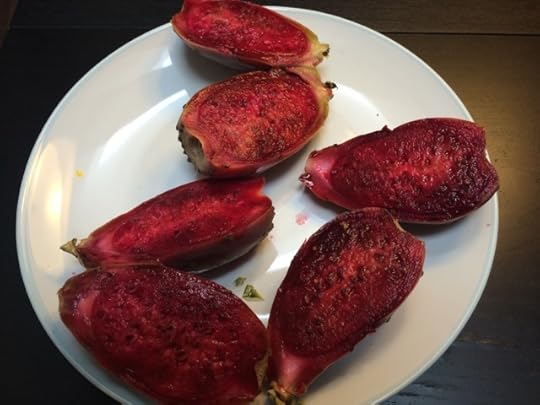
In the past, at the same time of year, I bought pomegranates, which are excellent and in season until Christmas. I also ate a lot of pomelos. I haven’t had any so far this year.
And to answer the question I always get: isn’t it bad for the environment to consume fruits from all over the world?
No. That’s a misconception. The transportation of fruit is very efficient and contributes only a small percentage to the total “energy footprint” of the food. You’d burn more gas driving to buy the food than what was used in getting the food to you from halfway across the world. Also, local fruits in the winter are kept in giant warehouses that gobble up a lot of energy, much more than an apple from New Zealand would.
I live within walking distance from my fruit market, so I’m confident that my energy “footprint” is actually lower than some of the local-food converts who drive half an hour to buy their locally raised eggs and winter vegetables. There’s nothing wrong with that, but the holier-than-thou attitudes of “locavores” doesn’t hold up to closer scrutiny.
November 26, 2013
What to Eat at a Vegan Restaurant
Last week we talked about foods to eat and avoid at a raw food restaurant.
Not everybody lives close to a raw food restaurant. However, most cities will have at least one or two vegan restaurants.
Generally speaking, vegan restaurants use a lot of oil. However, you’ll find some great healthy food there if you know what to order.
What to Avoid at Vegan Restaurants
Veggie Burgers – Generally, the burger patty is not the problem, but it’s what it comes with. A big bun, fried or roasted potatoes, and lots of vegan mayo in the burger. To make a healthier meal, replace the fries with a salad, and specify any creamy spread on the side.
Sandwiches — Generally, they are loaded with a lot of fatty mayo and are not nutrient dense (not enough vegetables).
Meat-Replacement Dishes — Dishes that try too hard to replace meat are generally loaded with fat or contain too much soy or gluten. For example, scrambled “vegan eggs” generally use an insane quantity of tofu.
What to Eat at Vegan Restaurants
Soups — Soups with lots of vegetables are generally fine to have. Creamy soups generally should be avoided.
Dragon Bowls — Many vegan places have a version of this bowl. It could be called the “dragon,” “buddha” or “macrobiotic” bowl. Generally, it includes brown rice, lots of raw veggies, some cooked veggies, and a sauce. So it’s a salad that mixes cooked and raw ingredients. It’s generally one of the healthiest choices at a vegan restaurant.
Salads — Salads are generally pretty healthy, but the dressing is usually very fatty. Ask for dressing on the side and order a bowl of rice for a complete meal.
Smoothies — Smoothies at vegan restaurants are generally okay, but avoid those containing syrups or added nuts and seeds.
Juices — Most fresh juices are fine to have.
Additional Guidelines for Vegan Restaurants
The menu at vegan restaurants tends to vary a lot more than at raw food restaurants. Your main concern will be to avoid fried foods and dishes containing too much oil. Often, ordering from the “sides” menu is a good idea, when completing a meal with a salad. You can often order simple steamed vegetables and brown rice to go on the side.
Of course, if you want to treat yourself, eat whatever you feel like! But if you seek health and want to eat vegan food that’s actually better for you than regular food, stick to whole foods, with lots of fruits and vegetables, and try to avoid foods loaded with oils.
November 19, 2013
What to Eat at a Raw Food Restaurant
Lately, I’ve been enjoying the fact that I live fairly close to a raw food restaurant here in Montreal.
It’s called Crudessence, and they have two locations in Montreal. They’re probably one of the most successful raw food restaurants in the world, and have done things the right way. Other raw food restaurants didn’t survive in sunnier parts of the world, so the fact that this one is thriving in a cold city says a lot about it.
I don’t live in walking distance, but it’s often on my way when I run errands. So, in the past month I’ve been going there every week, usually to pick up a few raw food items for the rest of the week.
I’ve criticized raw food restaurants in the past for offering food that’s too high in fat, too gourmet and generally unsatisfying.
But raw food restaurants can be a tremendous resource for improving your eating habits, especially if they offer take-out.
Raw foods don’t tend to go bad quickly, and don’t need to be reheated (obviously!), so you can pick up a few items at the start of the week and eat them throughout the week.
I recommend being careful with the menu at many raw food restaurants. A lot of their items are too high in fat and just not worth it.
So, here are my recommendations.
Soups
Raw or warm soups are generally okay to eat.
Appetizers
Get: Sushi Wrap. This is sometimes called a “Nori Roll.” Essentially, it’s a nori sheet with a nut pâté, filled with veggies and cut like a sushi. It’s pretty healthy.
Get: Corn tortillas wraps. If they’re made with fresh corn and not just nuts and seeds, those can be a good choice as long as they’re filled with mostly veggies and not a ton of “macadamia cheese” or whatever it’s called.
Get: Wraps. Sometimes wrapped in a collard leaf or something like that, and filled with a nut pâté and a ton of veggies.
Main Courses
Get: Salads. Most salads at raw food restaurants are very big and more satisfying than salads at other restaurants.
Get: Noodle dishes. Called “spaghetti” or other noodles, the sauce is generally good and it’s a good way to eat more raw veggies!
Avoid: Sandwiches. This is the raw version of a sandwich, usually made with sprouted grains or nuts and seeds. Tough to digest and mostly fat.
Generally Avoid: Burgers and Pizza. Again, the burgers and pizza crusts are generally made with sprouted seeds and nuts and seeds. It’s dry and personally not to my taste, but the burger at some raw food restaurants is okay.
Generally Avoid: Lasagna. Generally contains a tremendous quantity of macadamia nuts or cashews along with outrageous quantities of oil.
Smoothies
Get: smoothies containing fruit, green vegetables, and almond milk (in any combination).
Avoid: Smoothies with added nuts, cacao, syrups. And watch out for matcha, a green tea powder often added to smoothies in some raw food restaurants. It contains a lot of caffeine, so if you’re sensitive, make sure to avoid those smoothies.
Juices
All juices are generally okay to drink. I like the ones that are half-sweet.
Desserts
Most desserts in raw food restaurants should be avoided. They are often loaded with coconut oil and generally contain more calories per serving than the cooked version they are trying to replace.
Desserts made with fruit, such as “banana ice cream,” are generally okay.
Watch out for the cacao craze. Raw food restaurants generally use raw cacao in every single dessert. Cacao is loaded with caffeine (theobromine, actually, but the effects are the same), so if you’re sensitive, you should be careful.
Anything that tries to imitate a cheesecake or key lime pie — two popular raw food dishes — will likely be loaded with coconut oil and the extra calories will negate the benefits of your entire meal!
October 3, 2013
Healthy Idealism Vs. Healthy Realism
When I was in my early 20’s and had just moved to San Diego, I met a lot of people. Some people were really great. Some people were really crazy. Most were somewhere in between, but you always remember those on the extreme ends of the spectrum.
I particularly remember this guy named Scott, a fellow raw food enthusiast. Scott wasn’t just trying to casually follow a healthy lifestyle. He was obsessed with leading an absolutely perfect lifestyle.
He wouldn’t touch a drop of water or food that had been sealed or poured into plastic. Not to mention that the water wouldn’t pass his lips unless it had been sourced from the perfect pristine spring.
Everything he ate had to be completely organic, and of course completely raw. I always heard from him that computers and the electromagnetic frequencies emitted from them were the cause of many of the world’s ills.
Despite the fact that every time that I was with him he would lecture me about how the plastics in that plastic spoon I used to dish the guacamole` onto my plate are eventually going to be the end of me in one way or another, he was a really nice guy.
The saddest and most ironic thing was however was that Scott wasn’t all that healthy.
Everywhere he went he would stress about how everything he was encountering was harming him and obsess over attaining the perfect food no matter where he went. As a result, he was constantly stressed and probably not eating enough food to maintain a healthy weight either.
But here’s the thing: I was encountering all of these toxins on a daily basis as well. I spent hours working on the computer and being bombarded with EMFs. All the food I ate wasn’t even 100% organic or raw all the time, either. I drank water from the tap if I was thirsty enough, and I would inhale all of the smog and fumes from the city just like Scott and everybody else, yet I was much happier and healthier than him.
I’m not saying that smog is good for you, or tap water is the nectar of the Gods, or that the EMFs I’m absorbing from typing on my computer right now are good for you.
In today’s age, however, you have to have a healthy grasp of being healthy in the real world. You’re going to be much happier and healthier by having realistic expectations vs. setting the bar so high that you can’t ever attain it.
It’s not all going to go perfectly. Maybe you’ll overcook your broccoli just a bit and you lose more vitamin C than you’d like. Maybe you’ll be stranded in New York City for a few extra hours because you missed your bus and will have to inhale all the fumes for that much longer. You might even have a meal or two every now and then that isn’t exactly the definition of the “perfect” too.
And that’s okay. The whole point of eating and living healthfully is to feel good. Nothing is ever going to be perfect, and ironically stressing out about this is just going to cause you more harm than good.
September 19, 2013
The Best Time I Found to Exercise
There are many theories on this, but this is not a trivial question. If you fail to find the best time to exercise in your own life, it’s likely that you won’t be able to incorporate exercise in your life.
First, there’s the indisputable fact that the best time to exercise for most people is: whenever there’s time. Not everyone is lucky enough to work from home, but everyone has different work and personal commitments to take into account. If the only time you can exercise is on the weekends with short sessions during the week, then so be it.
When it comes to energy management though, every time of the day offers different rewards for exercise
Exercising in the Morning
For many, the morning is the best time to exercise for the simple reason that it gets done. When I was traveling a lot, I often woke up a little earlier to get my workout in for the day. That lost half an hour or hour of sleep can often be made up by going to bed earlier at night. And if you manage to exercise in the morning, you’ll start your day right. You’ll probably eat healthier for breakfast, and you’ll have a generally good vibe about yourself that will carry on during the day.
For me, mornings are not the best time to exercise because that’s when I tend to be at my most creative. If I spend time to exercise in the morning, then that means my work day will start later, and I’ll lose those precious hours of heightened creativity and productivity. For that reason, I almost never exercise in the morning except when I’m traveling.
Exercising in the Late Morning
Many people who work from home find this to be an ideal time to exercise: right before lunch or around 11 a.m. for many. You may have had a light breakfast in the morning, and had a few hours to get the gears of your body/machine in motion. At that time, energy is generally high and you haven’t had a heavy lunch so you’re ready to go. Exercising before lunch also increases your appetite for lunch, which for many is the biggest meal of the day anyway.
I will sometimes exercise at that time but it’s not my preference. Depending on my schedule, it may be my second choice for exercise time. But it’s not my first choice. I find that exercising before noon cuts my day in half and I find it difficult to get back in a routine after I have to take a shower, eat, etc.
Exercising in the Mid Afternoon
In the mid-afternoon (between 2 and 4 p.m.), most people exercise a drop in energy. You can rev up your metabolism and avoid this down period, caused by our circadian rhythms (in nature, it would be the perfect time to nap), by exercising around that time.
After many trials and errors, I have found that this is the best time for me to exercise. I’ve already gotten a lot done during the day, and I’m ready for a break. At first, you may find it difficult to find the energy to exercise around that time, because the body is naturally slowing down. However, the body is adaptable and if you get into a groove, it doesn’t take very long to get used to it.
I find that exercising around this time enables me to avoid this drop in energy. I might even take a quick nap before or after my workout. The key is to avoiding eating a big heavy lunch. Eat relatively lightly for lunch, and have a post-workout snack. Then, make dinner your biggest meal of the day (you’ll need to have some breakfast if you want this routine to work for you).
Exercising in the Early Evening
This is another popular time for exercise (between 6 and 9 p.m.) because that’s usually the only available time for exercise that many people have. Also, it’s a time when the body experiences a shift in energy and generally you feel more alert and awake, as long as you haven’t had your dinner yet, or had an early or light dinner.
If I didn’t get in my workout in the mid afternoon, I will often exercise at this time. But I will generally eat a very light, early dinner, and then eat more after the workout. If your workout was particularly intense and you’re not used to exercise at this time, you may find it more difficult to fall asleep. But the body is adaptable so overtime, you’ll find it easier to sleep.
Exercising in the Late Evening
This is not a particularly good time for most people to exercise because exercising this late will usually interfere with sleep. But if you tend to go to bed late this time may work for you. Energy is often still high until close to bedtime. And again, the body is adaptable and will adjust to your routine if you consistently follow it around the same time.
What about you? What’s your best time to exercise?
September 18, 2013
When to Feed Baby the First Foods
Guest Writer:
Karen Ranzi, Author, Lecturer, Raw Food Consultant, Raw Vegan Chef, Speech Pathologistwww.superhealthychildren.com www.youtube.com/superhealthychildren http://www.Facebook.com/CreatingHealthyChildren.com
When to Feed Baby the First Foods
The type of food given to baby is dependent on the age of weaning. All babies require mother’s milk for at least the first year of life to create the strong immunity and bonding necessary for baby’s physical, mental, emotional and spiritual development. The fat and protein in mother’s milk is sufficient for baby’s growth well into the second year. I encourage you to nurse as long as possible. Humans are the latest to mature of all mammals therefore our young require the longest nursing periods. I recommend a minimum of two years. If a mother is unable to nurse for at least the first year of baby’s life, then alternatives could be a wet nurse or milk bank. A last alternative could be raw (unpasteurized) goat milk. The combination of half raw goat milk and half celery/carrot juice has been done successfully for those who were unable to nurse and unable to obtain milk from a human mother. We must remember that human mother’s milk will always be best for the human baby.
Toward the end of the first year, and no sooner, if baby is equipped with teeth to chew, then bite-sized pieces of fresh, ripe, organic fruits can be given one at a time. Fruit is best as the first food because it digests easily in a young digestive system, moving quickly from the stomach into the intestines. It’s important to observe any reaction, as some babies are not ready to eat until well into their second year of life.
As soon as baby is accustomed to digesting a variety of fresh fruits given individually for chewing, begin to introduce green leafy vegetables in delicious green smoothies to provide additional minerals. It is best to start with the milder greens such as Romaine lettuce or spinach.
The first foods should not be blended. They should be bite-size pieces of whole ripe fruit. From the very beginning, mother should sit and chew slowly along with baby, as digestion begins in the mouth. We will be showing our children it’s just as important how we eat as what we eat.
Remember that for each child the progression will be a little different depending on dentition and real desire and readiness to eat. Some children are simply curious about foods but not yet ready to eat. The mother must be observant of her baby to predict the right timing for introduction of foods. Into the second year, baby can have diluted nut and seed milks and avocado for their fat and protein contents, but solid soaked nuts and seeds should not be given until later to avoid the development of a nut allergy as nuts require a greater digestive capacity.
All of this is described in much detail in my book Creating Healthy Children: Through Attachment Parenting and Raw Foods which is available at www.superhealthychildren.com
August 28, 2013
How I Upgraded My Raw Vegan Diet
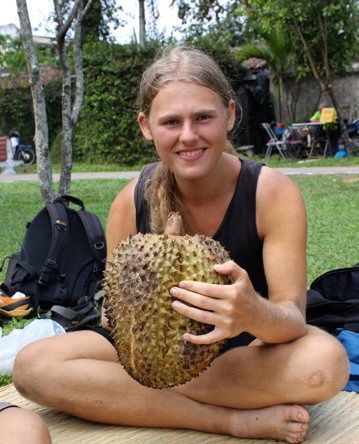 There are numerous things I really enjoy about a raw vegan diet. Environmental and ethical boons aside, a high-fruit, high-carbohydrate raw vegan diet is simple to follow, allows you to feel great, and is downright sweet and juicy. Eating all the fruit you care for is appealing to a lot of people for obvious reasons. There are few greater feelings than sitting down to lunch and seeing 2, 3, 4 or more pounds of perfectly ripe, fragrant mangos sitting in a bowl and knowing that they are all for you. Yes, just you.
There are numerous things I really enjoy about a raw vegan diet. Environmental and ethical boons aside, a high-fruit, high-carbohydrate raw vegan diet is simple to follow, allows you to feel great, and is downright sweet and juicy. Eating all the fruit you care for is appealing to a lot of people for obvious reasons. There are few greater feelings than sitting down to lunch and seeing 2, 3, 4 or more pounds of perfectly ripe, fragrant mangos sitting in a bowl and knowing that they are all for you. Yes, just you.
But with that all being said, I do believe that there are certain things that some people can adjust on their raw or mostly raw vegan diet to provide better results.
What inspired me to experiment even further with my diet and do more research?
I was cold. Downright chilly, in fact.
I never really saw it as an issue though. I just thought it was completely normal for me, during the wintertime, to need to wear 3 layers of shirts during the day and sleep with an electric blanket and a space heater. Granted, winters in eastern South Dakota USA can be pretty brutal, but it did get to a point where I wondered if it really was ideal to be so chilly all the time. I wasn’t under-eating by any means either (3,000 +calories from fruit every day), I was just cold.
I even objectively measured my core body temperature with a thermometer placed under my arms first thing in the morning. Most mornings, following the strict high-fruit, high-water, low sodium raw vegan diet I was, it was a frigid 95.4 degrees F.
Now there are some people in the raw food/health movement who believe that a lower body temperature like this is closer to ideal.
The theory is that most people are following an unhealthy lifestyle and eating plenty of unhealthy foods that cause their body to be in a constant fever, hence the average 98.4 F. And that made sense to me for the longest time. But then again, at the time I was more willing to accept what was said without doing my own research. That’s not what I want to teach anybody else to do. The wise words of George Carlin have taught me something important: “Question everything.”
So I started asking questions and starting to do a bit more of my own research. Are all forms of salt (sodium chloride) deadly poison? Is every single bite of cooked food you eat toxic? “Why are you asking me all these questions?” Good point. I’ll start answering some now.
The first thing I experimented with was adding just a little bit of salt to my evening salad. If you are wondering, it was just a pinch of that fancy pink salt you can buy in health food stores. It’s probably not any better or worse than most other kinds of salt, but from what I’ve researched, the high-heat-treated, chemical-laden salts many people use more than likely aren’t the best choice.
Dr. John McDougall, a medical doctor who’s promoted a low-fat vegan diet since the 1970’s, has some interesting fact-based things to say about salt in this presentation here: http://www.youtube.com/watch?v=yZ3hS9jpmm0
Honestly, it felt weird adding salt to my otherwise whole, fresh, ripe, raw, organic salad. Sacrilegious even. I had been told, and believed for years, that salt was deadly poison. Lucky for me, I didn’t die of heart failure or a stroke after the second bite.
It tasted amazing. And this is coming from just the very tiniest pinch of salt, mind you. After the first 2-3 days of doing this, I started to notice myself feeling less stressed and ultimately just more at-ease than I ever had before. I gradually added just a bit more salt after several days/weeks as well and felt better than ever.
Before, after eating my typical evening salad of water-rich foods of 3-4 or more lbs. of tomatoes, lettuce, celery, and cucumbers, I would feel like while in my mind logically I should be relaxed, my body just wouldn’t follow. Not to mention having to pee 3-5 times in the next few hours before bed.
Now it just felt like my body was happier, I could feel blood and warmth rush to my hands and feet, and I enjoyed my food more. Something was working. I also noticed a profound difference in the quality of my sleep. No more 4am adrenalin-surge wakeup coupled with a near exploding bladder.
But I also decided to experiment with something else totally crazy. After 2 ½ years of following a very strict, 100% raw diet (no pasteurized fruit juice or questionably raw dried fruit at all), I decided to try to eat some cooked food again. I figured organic steamed kale would be a good choice. I did end up burning my finger and realized I was a bit rusty at working with hot pots and pans, but the kale tasted fantastic.
Then in the coming evenings, I decided to steam up some winter squash. And then potatoes. All of them digested perfectly with no issues and the only side effects I experienced were sounder sleep, warmer hands and feet, feeling more at-ease, hair and nails growing significantly faster and thicker, and enjoying my food more. Since then, I’ve bumped my core body temperature back up into the 98’s degrees F. as well. Overall, I just felt better.
So what are the big takeaways from this? What am I doing differently? I’m eating a 100% vegan, fruit-based diet, predominately raw, but I also eat a bit of salt and some choice cooked foods when I desire them, like steamed root vegetables, rice, quinoa, and legumes. I don’t eat cooked food every meal, just when I desire it. Sometimes that’s every night of the week (mostly in the evening) or maybe just once or twice per week. Raw fruit is still my staple and where I get most of my calories.
Do note when I say, “cooked food” that I’m referring to healthy, clean, mostly whole, plant foods. I think most of us can relate to how silly that raw-food enthusiast sounds when they eat deep-fried soy protein fritters bathed in MSG sauce, feel pretty stodgy, and then conclude that all cooked food is no good. Sigmund Freud may have said that sometimes a cigar is just a cigar, but cooked food is not just cooked food.
I also just drink water and fluids until my thirst is quenched, not passed it, and balance the juicier foods I eat with drier foods. If I eat a mess of mangos, I’ll eat some raisins with them. If I have a big juicy salad, I’ll have some dehydrated vegetables with it. My bladder is feeling much better as a result, and I’m feeling warmer and happier.
Besides faster and thicker growing hair and nails, better sleep, and a less stressed mind and body, my skin is also moister (no more dry, flaky skin in the winter) and my physical endurance and strength gains have improved significantly. It feels good being able to consistently lift more weight every time I go into the gym. Now if I could just find a personal trainer to help me with my bench-press form…
Again, I’m not telling you that you have to put some salt on your salad, that you need to eat some cooked food, or that you need to do anything differently than what you’re doing now. I’m just encouraging you to ask some questions and think for yourself.
The way I see it, if what it takes for someone to be happy and healthy on a conscious, compassionate vegan diet is to eat some steamed lentils with a splash of coconut milk and a pinch of salt and abandon their “100% raw” label, then I say go for it. I’d rather see a society of happy, healthy people eating plants vs. intermittent 100% raw foodists who flip-flop between banana smoothies and bacon sandwiches. Consistency and sustainability is the goal.
So maybe your diet doesn’t need an upgrade. That’s awesome. Keep doing what you’re doing. But if you feel you might be able to experience better health by opening your mind just a little further, then I’ll be waiting right here with a bowl of potatoes mashed with coconut milk…
August 20, 2013
One Year of Traveling for Free
Last Saturday I told you about the five trips I took this year for free or nearly free using the methods I learned from Shelli that we taught in the course, “How to Travel the World…”
I promised I would get Shelli to reveal all of the trips she took this year using this method.
As I told you, I’m only using the method at the “intermediate” stage. Shelli is truly a master in the art of free traveling!
Here are all the trips she booked for 2013 and exactly how much it cost for each.
My Year of Traveling in Style and Luxury on a Cheap Budget
by Shelli Stein
This year I’ll be turning 59.
A few years ago, I decided the time was right to start traveling abroad — something that always has been an ambition of mine, but one that I never fully accomplished.
I didn’t want to wake up at 60 and start this new decade of my life thinking of all of the things I wished I had done and seen when I was younger. So I decided I would learn everything there is to learn about traveling using points and miles.
I spent a considerable amount of time learning these methods from scratch. At first, I didn’t know what I was doing! But little by little, I discovered how to make the method work. I taught my old friend Frederic how to do it, and last year he asked me to create a course with him on the topic. It was an honor to be able to reach out to so many people. I want to inspire them to achieve their travel dreams, just as I am. As I said to Frederic many times: this is about making your dreams come true. It’s about traveling to the places you’ve always wanted to visit, at a price you can afford.
Frederic asked me to list all of the trips I booked in 2013, and give details about each trip. I’m happy to do that!
So here we go! Let’s take a look…
1. Europe in the Spring
My first trip of the year was to Budapest and Vienna, with my partner. Both cities were absolutely wonderful and a first-time experience for us.
We flew using United, Lufthansa and Austrian Airlines. All in business class. One highlight of the trip was during the four-hour layover in London, England. Because we traveled business class we had access to the lounge. Much to our surprise and delight, the lounge had showers. After a long overnight flight from the west coast to Europe, it was great to be able to take showers and freshen up before the rest of the trip!
The entire trip cost me $247.10 in taxes and fees for the plane tickets. The same trip out-of-pocket would cost between $4000 and $5000 per person.
For hotels, we stayed for a week at the Budapest Hilton Castle District, all on points. Wonderful hotel, great services and amenities, and excellent location! Regular price would be $200 a night, but we got it for free.
In Vienna, we stayed for a week at the Hotel Bristol, which is a Starwood Preferred Guest hotel choice. I used points and paid $99 a night. This is an amazing luxury hotel right near the Vienna opera house. Regular price for this hotel is around 230 euros a night, or around $300 U.S. We were upgraded to a suite room with an incredible view of the opera house.

Hotel Bristol, Vienna
2. Europe in August 2013.
The second trip of the year is one I just completed! My partner and I just came back from a trip to London and Paris.
We flew with United and US Air, all in first class. Yes, not business, but FIRST! Normal price for this would be $4200.
I’ve always wondered what first class travel was like, so I decided to splurge. It was even more private than business class, and the lie-flat seats really make the journey much more comfortable. The food and amenities, like pillows and blankets, were better as well. There were two particular benefits of flying first class. One was that our plane was very late getting into San Francisco for our connection to London. Not only did they hold the plane for us, but they sent an escort to meet us and get us as quickly as possible to our London flight. This was amazing because we would have missed our plane and would have had to spend the day at the San Francisco airport instead of London! The other benefit of flying first class was that we were given special vouchers for clearing customs in London, so that when we got off the plane we scooted right through in our own line.
In Paris, because we flew back on US Air Envoy class, we didn’t have to stand on any long lines at the airport for security or to check in, so we had more time to enjoy breakfast in the lounge. The food and service of Envoy class was great, and they even have an espresso machine on board the plane!
Total cost was $139.80 in taxes and fees.
Hotels: In London, we stayed a few nights at the Andaz Hyatt Liverpool using certificates I could buy from Hyatt. I bought the certificates for $260 USD a night (that includes all taxes and fees).
I’ve always wanted to try a Hyatt Andaz hotel and really enjoyed it. I loved the boutique atmosphere of the hotel and the service and Andaz team were excellent. I’ll be back!
The other nights we stayed at the London Hilton on Park Lane for free.
This hotel is right across the street from Hyde Park and Buckingham Palace and the views from our upgraded 22nd story room were wonderful.
So if you count the nights we paid and the nights that were free, we spent $130 a night for top London hotels. Remember that London and Paris are very expensive cities! So our average for hotels, for two people, was very low, considering the level of luxury we enjoyed.

London Hilton on Park Lane

Andaz Hyatt Liverpool
In Paris–We rented an apartment and then spent two free nights at the Paris Park Hyatt Vendome.
This is a luxury hotel that is absolutely gorgeous. The spa was incredible as well. And even though it’s a very luxurious and expensive hotel, the manager sat talking with us for quite some time. We enjoyed our time with him. I felt he really wanted to know about our experience with the Hyatt hotels and he even gifted us with beautiful scented candles to remember our stay at his hotel.
So if we amortize lodging for the whole trip, the paid nights and free nights, it comes to about $85 dollars a night.
That’s an amazing bargain for such wonderful hotels in incredible world-class cities.
3. Israel in the fall.
I booked another trip for this fall to Israel. This time I’m going alone.
I’ve always wanted to go to Israel, but always seemed to put it off. Either I didn’t have the time or felt I didn’t have the money to spend on a trip like this. But now that I’m leveraging miles and points, I don’t have to put this trip off any longer. I’ve very excited about this adventure and this will be my first trip to this part of the world.
I’m flying using several airlines: United, Lufthansa, Swiss Air, and US Air, all Business class.
The total for the flight was $162.17 in taxes and fees. Again, out-of-pocket this would be $4000-5000 in business class.
I’m staying and using points in Tel Aviv at the Sheraton for $110 a night. Regular price would be around $300 a night, with taxes.

Sheraton Tel Aviv
4. Winter Trip to Chile
My last trip for 2013 is to Chile, with my partner. We’re flying American in First Class and Lan Chile in Business class. Total cost to me was $77.50 in taxes and fees. Price for this in business class would be $3000-4000.
We have no hotels there because we’ll be visiting family.
Seventeen years ago my cousin, who I grew up with, moved to Chile to be by his wife’s family. I haven’t seen him, except for a recent day in California, which inspired this trip. I have no idea what his life is like or what it’s been like for him to live in South America all these years. I’ve never been to South America as it’s always felt too far away for me to travel. Well not any more. I feel so lucky to be able to make this trip, and my cousin is beyond excited as well. He’s so excited I keep getting emails telling me to practice my Spanish!
5. Hanoi and Bangkok in 2014
The last trip I booked, which will be my first trip in 2014, is to South East Asia.
I’ll be visiting Bangkok and Hanoi, flying using Thai Airways, Asiana and ANA all in business class. Fees for the whole trip were $100 in taxes and fees. Tickets going this far in business class can cost up to $10,000, but a minimum of $6000! So it will be an incredible experience.
No hotels booked for this one yet!
–
So as you can see, my trips were not all 100% free, but my method is more about stretching my travel budget, because airfare and hotels will always be the most costly part of any trip. This way I can travel more often.
So perhaps instead of one big trip a year we can now do three. For me what I want is to be able to travel to places I’ve always wanted to see, taking these long haul trips in business class and experience some 4-star hotels. Using miles and points allows me to see the world on a much more affordable budget!
I truly hope hearing about all these trips will inspire you to learn these methods so you too can visit the places you’ve always wanted to see.
NOTE: Get 50% off the course by using coupon code SHELLISTRIPS. Coupon expires on August 25th. Click on image below to learn more about the course. Make sure to use coupon code upon checkout.
August 6, 2013
Which Culture Has The Healthiest Diet?
Health has been a passion of mine for quite some time. Another passion of mine also happens to be traveling the world and experiencing different cultures.
One thing you’ll quickly notice once you get out of the typical North-American culture is that people around the world have vastly different diets from one another.
At the same time, different cultures also experience different levels of health. So today we’ll be taking a look into the specifics of several of the most notable cultures around the world and see how their food choices contribute to their health, for better or for worse.
Keep in mind that many of those cultures are becoming more and more Americanized, for better and for worse. However, we’ll look at the traditional element of each diet, which tends to predominate culturally in spite of the westernization of the planet.
France
Much to the confusion of traditional wisdom from most nutritionist of today, in France people traditionally tend to eat a diet rich in high-fat foods that most people would consider unhealthy, yet they experience much lower rates of heart disease and stroke than most other countries in Europe and North America, as well as smaller waist lines.
The notion of butter and croissants equating to lower rates of heart disease has been deemed, “The French Paradox”.
But taking a closer look at not just the diet, but the overall lifestyle as well may be the key to understanding their good health.
Despite a diet rich in butter and cream, the French also have several cultural practices that contribute to a healthy lifestyle. For example, the typical French breakfast is something light like coffee, fresh fruit, and a small croissant.
The lighter breakfast, and for some French people, entirely skipping their morning meal, allows the body to spend more time detoxifying without being burdened by a heavy breakfast first thing in the morning. And while the verdict is still out, there may be something to the antioxidants in the moderate amounts of red wine the French regularly drink with meals too.
Another thing you will notice in France is that people walk everywhere, and consistent low-level activity is just a part of their daily lives. Add that to a healthy dose of quality fresh fruits and vegetables available to and consumed by the locals, you definitely have a big improvement over the typical Western diet and lifestyle. But with the average life expectancy of 82, France doesn’t take the prize for the healthiest culture just yet.
Thailand
Thailand is a country that I have a fair bit of experience traveling in. One thing I’ve noticed over the years is that the more affluent the Thai people get, the more money they have to spend on Western foods like ice cream and fast food.
As with any culture, when this happens you’ll always notice their waistlines expand and health deteriorate. But overall, the typical Thai diet is pretty healthy.
Fresh fruits and vegetables play a big role in the traditional Thai diet. Most of the fruits and vegetables eaten by Thai people are purchased from the market on a daily basis. In most cases, the fruits and vegetables were picked just that morning too.
When it comes to actual mealtime, they are big on carbohydrate-rich foods like rice and rice noodles. I’ve seen Thai people carrying bowls of rice so big that you would assume that it’s for their entire family, but they sit down and eat the whole thing themselves with some stir-fried veggies and soy sauce! Many Thai people eat meat, but it’s treated more like a condiment. For example, they will have a few slices of beef or pork on top of their rice and vegetables, or a small piece of fish. Meat is certainly not the focus of a meal as is common in the West.
People tend to think that carbohydrates are fattening, yet some of the leanest cultures in the world eat a diet where carbohydrates predominate.
Almost no dairy foods are traditionally consumed, and instead things like coconut milk are more prevalent in Thai cooking.
Traditional Thai people tend to be lean and fit as well. But they also tend to be very heavy on the vegetable oil with much of their cooking, and eating fried street food is the norm for many Thais.
I’ve frequently noticed Thai people having varying degrees of skin problems too, which may be attributed to the excess of oil and fried food in the diet. It also may be genetics, or the fact that so many Thai people smoke cigarettes too. In spite of this, the average Thai does live to 74, not too far behind many Western countries.
Mediterranean Countries
“The Mediterranean Diet” is something that has been highly popularized in the diet scene. There are many countries in the Mediterranean region, and their foods and culture do vary a bit, but there are several countries like Italy, Spain, Greece, and Croatia that all experience good health and have a similarly healthy diet.
The focus of diets in the Mediterranean region is on primarily whole plant foods like whole grains, beans and legumes, fruits, vegetables, and pastas. Things like lean poultry and seafood are also included. Most of the fat in their diet comes from plant sources, namely olive oil, olives, and the fats found in nuts and seeds.
The Mediterranean regions also attribute much of their good health to their daily lifestyle. People mostly walk from place to place and post-meal walks with family are common.
There is also an emphasis on communal eating with good friends and family that creates a happy and relaxed environment. Anyone who’s experienced losing their appetite when they are stressed out, or getting a sour stomach upon becoming upset shortly after eating, can attest to how important it is to eat in a relaxed atmosphere.
This active and relaxed lifestyle combined with the abundance of fresh fruits and vegetables in the Mediterranean region certainly contributes much of the area’s good health. Italy and Spain’s average life expectancy clocks high on the list at 82 years, while Greece ranks just behind at 81.
India
Traditional Indian food has a lot going for it in terms of health: generous doses of antioxidant-rich spices like turmeric, a base of healthy carbohydrates coming from rice and whole-wheat roti bread, and a plethora of vegetable-heavy dishes using cauliflower, tomatoes, potatoes, and all sorts of greens. Not a bad start.
When put into practice however, it’s easy to turn otherwise healthy food into something not-so-healthy thanks to plenty of oil and ghee (clarified butter common in Indian cooking).
Particularly in the northern regions of India, where ghee, paneer cheeses, yogurt, meat, and fried food is consumed much more regularly and in higher quantities, type 2 Diabetes is among the most prevalent in the world. In the southern parts of India, rice and vegetable-based meals are the focus, and most of the dairy in cooking is replaced with coconut milk.
This results in more vegetarian and vegan-friendly cuisine, and coincidentally lower rates of disease than the ghee-slinging parts of North India.
While the diet of most people in India is an improvement over the junk-food-filled standard Western diet, the average Indian still only lives to 65 years. This may be due to other factors, such as hygiene and poverty levels.
California Beach Diet
Worth mentioning as well is the diet of the stereotypical California health/fitness fanatic, as California has always been a major hub for the health movement.
The focus is on preferably locally sourced sources of lean protein like fish and poultry, fresh local fruits and vegetables, “good carbs” like quinoa and brown rice, and “good fats” like avocados and nut and seeds. This results in a diet moderate in fat and carbs and low in processed, refined junk foods.
In terms of staying fit and looking good, this approach obviously works well as many fitness models and actors and actresses abide by a regimen like this.
As far as life expectancy, they aren’t lacking in this department either. The average Californian lives to 80.8 years, in the top three for states in the United States.
Japan
There’s been plenty of talk about the Japanese and Okinawans and their sweet potato and rice-based diets fueling the longest life expectancy in the world.
The average Japanese man lives to 79 while the average woman lives to 86, resulting in the world’s highest average life expectancy of 83.
But what’s so special about the Japanese diet? Is there one secret ingredient that allows them to live so long? Not so much one specific thing, more so the culmination of more than a few things working in their favor.
The Japanese and Okinawans are known for consuming a plant-based diet with rice, rice noodles, and Japanese sweet potatoes being the base. Moderate amounts of fish and seafood are regularly consumed as well.
In addition to the seafood consumed, generous amounts of seaweed, common in soups and sushi, are consumed regularly and contribute to a diet particularly high in the mineral iodine.
Ample amounts of soy products are regularly eaten, including tofu and edamame, as well as traditionally fermented soy foods like super-salty miso (miso soup anyone?), soy sauce, tamari, and tempeh.
Green tea is sipped with and in-between meals, adding a huge dose of antioxidants to the Japanese diet. Adding another mini-paradox to this mix is the amount of sodium consumed via foods like miso, tamari, and soy sauce: The average American consumes 3,500mg. of sodium per day while the average Japanese consumes 4,650mg. or more per day, yet the Japanese experience significantly lower rates of heart disease.
What can we learn from observing the health and food choices of different cultures from around the world?
Most of them consume a plant-based diet rich in fresh fruits and vegetables and avoid or minimize the consumption of overly processed junk foods like candy and other packaged foods.
But perhaps just as important is the lifestyle that these people live. Regular low-level activity like walking, communal meals enjoyed with good friends and family in a relaxed environment, and an overall low-stress lifestyle all contributes to the health and longevity of the world’s healthiest cultures.
My Thoughts:
French Diet: Personally, I think that the primary factor that results in the French’s superior health is their overall low-stress and less chaotic lifestyle (compared to those of us in the West) combined with a good dose of fresh produce and regular activity, like walking and biking. While I’m not going to argue in favor of drenching everything you eat in Hollandaise sauce, there is something to be said about easing up and just enjoying your life instead of stressing out about every little aspect.
Thai Diet: I think that the Thais certainly have a leg-up over the competition, considering they follow a predominately plant based diet focused on healthy carb foods. But when it comes down to how most Thais actually prepare the food, there’s far too much oil and fried, greasy food to be considered a truly healthy diet.
Mediterranean Diet: The bounty of amazing quality fresh fruits and vegetables is a big boon to the Mediterranean-style diet. And just like the French, relaxing and regular activity certainly plays a key role in their good health. Despite what marketers might want you to think however, you’re not going to magically get healthy by pouring olive oil all over everything you’re already eating!
Indian Diet: Like the Thai diet, the Indian diet has a good start with plenty of vegetables and healthy carbs like rice and other whole grains. But the slew of ghee and other high-fat dairy foods so common in Northern Indian cooking just ends up bogging down otherwise healthy food. If you had the choice, I would opt for a diet more similar to that of southern India: lower in fat and higher in plant foods.
California Beach Diet: The lower fat diet and abundance of fresh produce is a great start. But realistically, how many times per week can someone eat bland skinless chicken breast, salad, and a bit of quinoa? Not very many people, unless they are ultra-motivated to fit into that size two dress for their upcoming movie. So while it’s a good start, I don’t think it’s a great long-term diet for most people.
Japanese Diet: The Japanese have a lot going right in terms of their diet: high in carbs and vegetables, a cultural norm of eating until you are satisfied vs. overstuffed, and quality traditional foods that have been consumed by them for centuries, like natto. All are things that I definitely approve of.
But while the Japanese might experience the best health of any other place in the world, you don’t have to pick just one culture or practice to abide by. Why not take the best qualities of each?
Question of the day: Which culture do you think has the healthiest diet?
Some sources:: http://www.ncbi.nlm.nih.gov/pubmed/21...
http://ije.oxfordjournals.org/content...
http://en.wikipedia.org/wiki/List_of_...
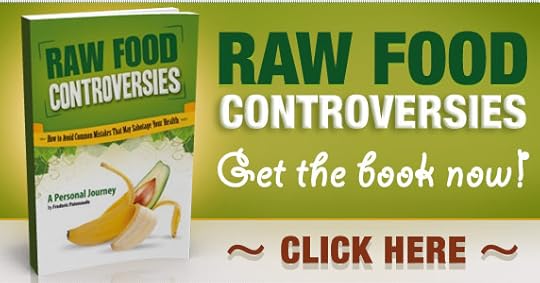
July 30, 2013
Forbidden Raw Foods I Now Eat
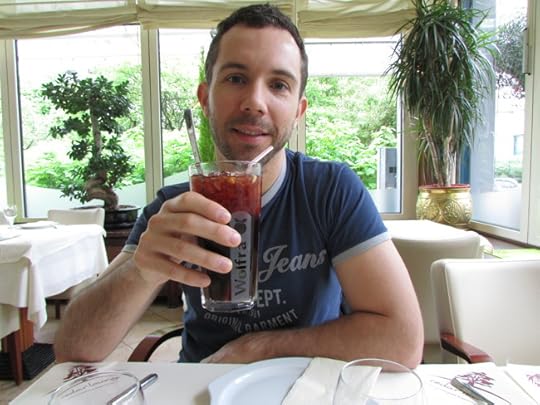
Enjoying date lemonade with pine nuts at Lebanese restaurant
I used to be known as a more militant raw vegan. And when I look back and some things I wrote over 10 years ago, I admit that some of my writing was a bit over-the-top and militant…
Perhaps it was the enthusiasm of youth. Perhaps it was my passionate nature.
But I did enthusiastically rage against certain foods that I now eat today.
Although I do admire the consistency of certain health advocates who have been saying essentially the same thing over the last 20 or 30 years, in many cases this can be combined with a bit of stubbornness as well. I try not to be too stubborn, and overtime I’ve changed my mind on a number of topics.
Here are a few foods that I’ve previously tried to eliminate or spoke against that I now consume.
Protein Powder
I wrote about protein powders and condemned them in some articles I published in the past. In general, what I wrote about them is true: they’re refined, of low quality, and most people do not need more protein in their diets.
However, in the world of vegan or raw vegan nutrition, I find them useful. I’m talking about well-designed protein blends from plant-sources, such as hemp, pea, rice, and so on (not soy).
A raw vegan diet can be especially low in absorbable protein — in fact too low — which makes these supplements particularly useful. People who find that their morning smoothie just doesn’t sustain them for very long can add a scoop of protein powder and find that miraculously they are satisfied for much longer without many added calories.
I have tried a few and personally like the Vega-Sport brand the best, as well as Raw Power. I use it in my post-workout smoothies, along with almond milk and a couple of bananas.
Nuts
I’ve never been against nuts but I’ve been against eating too many nuts, which is often too common in raw-foodists. I still think that eating more than one or two ounces of nuts a day is excessive.
When I first became a raw foodist (a long time ago, in 1996), I avoided all nuts, believing them to be unhealthy in any amount. I then over-consumed them for a few years, and later eliminated them again or tried to get my fat from avocados instead.
Nuts are extremely healthy when eaten in moderation (about one ounce a day for most people). In spite of the fat content, they won’t make you fat because they keep you satisfied for a long time, especially if you take the time to chew them. My favorite nuts are currently almonds, but I also consume and enjoy other nuts.
Dried Fruits
Dried fruits can be dangerous for raw foodists, because they tend to overeat them easily. They can also get stuck on the teeth and cause decay if one is not careful about carefully brushing teeth after.
The reason why most people on raw food diets tend to eat too many dried fruits is because the raw food diet is low in calories. So anytime the body comes across a concentrated source of calories the mind says is “raw” and “okay to eat” it goes a little crazy and sends signals to fill up.
I find that eating a more varied diet now allows me to eat dried fruit without overeating. I love prunes and figs the best and will eat them whenever I need a snack, or during exercise when I need extra energy. The normal amount to eat is something like 3-5 dried prunes or figs or a small handful of raisins. Eating significantly more than this can cause excess gas.
Fruit in Salads
According to typical food combining rules, fruit should always be eaten alone. However, through experimentation, I have found that fruit combines well in salads. It also tastes great. So I don’t hesitate to throw in some peaches, berries or other fruits in salads, even when the salad contains fat like avocados or olives.
Salt
I spoke against salt before, when I was more influenced by natural hygiene. And I still think that consuming very little salt or no salt at all is probably best for health, as long as one consume plenty of natural sodium in the diet (generally by eating lots of leafy green vegetables).
However, most raw vegans would be well advised to include a little salt in their diet. Their diet is so watery and fruit-heavy, and often eating enough green vegetables on a daily basis can be a challenge. If you look at the diet of many of the raw vegans who have blogs, you often find that they have many days where they consume mostly fruit. They combined that with a lot of exercise where they are profusely sweating. On top of it, they tend to drown themselves in water. They also tend to get up 3 to 5 times at night to pee.
All of this means that they are at risk of electrolyte imbalance, where their bodily fluids are essentially too “diluted.” A quick way to fix the situation is to sprinkle some salt on your salads and stop drinking so much freakin’ water if your diet is essentially made of food that are 90%+ water.
One raw vegan, Chris Randall, saw the light on this one and introduced salt to a low-fat raw vegan diet, solving many of the nagging problems that were still plaguing him on his raw vegan diet, such as cold extremities. (See: http://180degreehealth.com/2013/06/increase-metabolism-on-a-vegan-diet).
Spices
Natural Hygiene is generally against spices. I used to be against spices (garlic, hot peppers, dried spices, etc.). I now find that this is just the wrong enemy.
There are a lot of things that can really harm your health and cause disease, and spices are just not one of them.
Let’s talk about lack of exercise, excess calories, processed foods, and other nutritional evils. But spices?
Many spices, such as turmeric, are actually loaded with cancer-fighting antioxidants. They also make a bland diet much more palatable!
Some people are sensitive to the “heat” in certain spices, such as hot peppers. In this case, avoid or minimize them. But otherwise, there’s nothing inherently unhealthy about consuming some spices.
I do make an exception for raw garlic, and I’ll explain why later.
Supplements
I used to be generally against all supplements but this naive phase didn’t last very long. Certainly, blindly consuming supplements is not a good health practice. But it’s also not advisable to ignore common nutritional deficiencies that can occur on raw vegan diets, that can easily be corrected or prevented with the right supplement.
Vitamin B12 is something everyone should take. And for most of us not spending all of our time wrinkling our skin in the sun, some form of reasonable supplemental vitamin D intake is advisable. Other supplements may be needed, depending on your needs. Calcium may be advisable, as well as certain B vitamins. But each person has different needs and you should discuss this with your health professional and after taking some blood tests.
Forbidden Foods That Are Still Forbidden
There are a few foods that I condemned a while ago and still are on my “do not eat” list. I won’t talk about the obvious unhealthy foods, but a few foods common in raw vegan circles.
Raw cacao
I don’t trust raw cacao. I’m not saying I never eat chocolate. I just won’t touch raw cacao. To me, it’s nothing more than a fad. I’ve gotten sick more than once eating raw chocolate concoctions (including one memorable event after a raw food event where I gave a conference. After the event, I was driving back home and did so right after consuming a raw cacao cake. I got so sick with horrible headaches and nausea that I had to sleep in my car after quickly finding an exit on the highway. I was too sick to drive any further and find a hotel room even), and know too many people who also did.
If I eat chocolate, I want it to be regular, old-fashioned chocolate. And I acknowledge that it’s just a treat. Although chocolate (and raw cacao) is loaded with antioxidants and certain nutrients, it’s also loaded with saturated fat and typically some sweetener. It’s also a stimulant, like caffeine.
For some reason, I just don’t trust the people who promote raw cacao and where they are sourcing it. Being a fermented product, I sense that there’s a quality control issue there that can lead to potential problems. I won’t touch raw cacao with a ten-foot pole now, but an occasional (cooked) chocolate treat is okay with me.
Raw garlic
It’s supposed to be healthy. And some raw foodists love it (except the natural hygienists!). I spoke against it before, and I still don’t like it today. Every time I eat raw garlic, I feel horrible after. It seems to want to come out of every pore of my skin. It gives me a horrible aftertaste in my mouth, and even disturbs my sleep (with mysterious nightmares). Yogis have stayed away from garlic for hundreds of years (possibly thousands!), calling it a “brain toxin.” According to the enlightened, it disturbs the mind during meditation.
I have no problems with cooked garlic, as long as I don’t use too much of it. But some minced garlic sautéed in a pan can give almost any other food a great taste. Cooking probably dissipates the irritating oils in garlic.
For some reason, raw onion doesn’t give me the strong negative effects of raw garlic.
What about you? What are the forbidden foods you now eat?
Frederic Patenaude's Blog
- Frederic Patenaude's profile
- 11 followers


